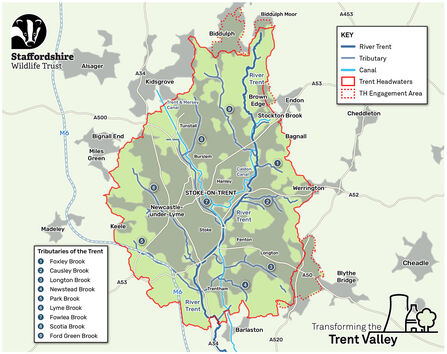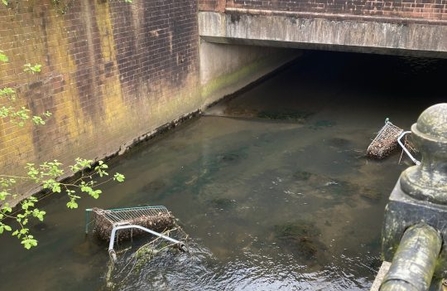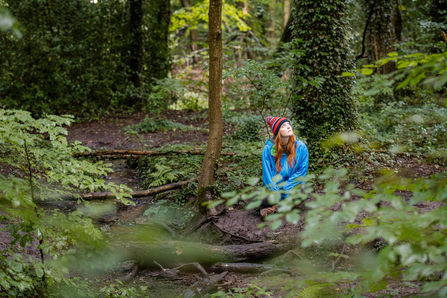A new vision for Stoke-on-Trent, urban Newcastle-under-Lyme and Staffordshire Moorlands
Following on from our successful scheme, Transforming the Trent Valley, in the east of Staffordshire, Staffordshire Wildlife Trust, in partnership with others, has completed an 18-month study of the Trent Headwaters between April 2024 and September 2025.
Funded by The National Lottery Heritage Fund, we explored the feasibility of a new, landscape-scale partnership project with a focus on nature and heritage.

What did we propose to do?
We set out with the intention to undertake the following:
- Develop a new Partnership in Stoke-on-Trent and the wider area (including Newcastle under Lyme and Biddulph) of local councils, universities, environmental charities, voluntary sector organisations and like-minded businesses.
- Engage local communities and other partners to better understand the needs, opportunities and priorities of the area.
- Establish the geographical and thematic focus for future projects based on the identified priorities.
-
Create an outline of projects for development that respond to these priorities.
We have successfully achieved this and are ready to use everything we have learned and put in place to develop a new scheme of work to transform the Trent Headwaters.
What are the Trent Headwaters?
The Trent Headwaters are the start of the River Trent in Staffordshire. This area includes places like Biddulph Moor, Stoke-on-Trent, Newcastle-under-Lyme and Trentham. The headwaters are made from where rain, melted snow, and water from the ground all flow into the River Trent. This is called a watershed and is important because it helps shape the river and the land around it.
The River Trent begins its 298km journey across the Midlands from Trent Head Well in Biddulph Moor. From here, it winds through villages and into the heart of the city, gathering waters from tributaries flowing through Stoke-on-Trent and Newcastle-under-Lyme.
We have traced these watercourses and mapped the watershed. But a landscape is more than its geography, it is also formed by the people who live there. Communities beyond the physical boundaries of the headwaters feel a strong connection to the River Trent: its industrial past, its cultural legacy, and the spaces it weaves through. We have included these communities within our landscape to ensure that the the Trent Headwaters is not defined only by its geography, but by its living, human landscape as well.

Our Vision
Our vision is to create a restored, resilient headwaters landscape where rivers, wildlife, and heritage flourish, driven by strong partnerships and empowered communities – ensuring a sustainable future for Stoke-on-Trent, Newcastle-under-Lyme, and Staffordshire Moorlands.
We have undertaken an in-depth study of our landscape and have a deep understanding of our natural and cultural heritage. We have spoken to the communities who know this place best and know what their needs and priorities are. There is still so much more to do, but we have a clear vision, a bold ambition and the drive to make tangible change for the future.
Watch our short film which sets out our vision for the Trent Headwaters.
Our Aims
Over the coming decade, we set out to achieve the following aims:
- To conserve, enhance and restore the cultural, historic and natural heritage of the Trent headwaters.
- To empower communities to shape, lead and co-create the future of their landscape by supporting informed, independent action and fostering meaningful engagement.
- To improve physical, digital and intellectual access to the landscape heritage, creating better links and opportunities for learning, enjoyment and wellbeing.
- To create a lasting legacy of a resilient and restored landscape for both people and wildlife.
Our Partners
Our 10-year vision is supported by the following partners who together form the Transforming the Trent Headwaters partnership
Appetite
Biddulph Town Council
Canal and River Trust
Environment Agency
GeoConservation Staffordshire
Groundwork West Midlands
Keele University
Newcastle-under-Lyme Borough Council
OUTSIDE Arts
Stafford Borough Council
Staffordshire County Council
Staffordshire Moorlands District Council
Staffordshire Wildlife Trust
Stoke-on-Trent City Council
Support Staffordshire
Together Active
Trent Rivers Trust
VAST
Wild Trout Trust

SWT
Exploring our natural heritage
We have mapped the Trent Headwaters as a defined landscape area.
We have examined maps to identify the watercourses (streams and brooks) that feed into the River Trent as it rises in Biddulph Moor and flows through Stoke-on-Trent. We wanted to understand where these watercourses are and what condition they are in.
We then explored the different habitats that are supported by our rivers, streams and brooks. Do they flood? How are they impacted by high temperatures? What species live there and what species are missing?
We used this information and learning to help us identify projects that can be delivered to make a positive difference to wildlife and the environment.
You can find out more about our research in our Natural Heritage Audits here.

SWT
Examining our cultural heritage
We reviewed the Historic Environment Record to understand what is already known about the Trent Headwaters landscape. We wanted to identify sites of historic or cultural interest.
We spoke to and networked with history and heritage groups, organisations and universities to learn more about the area. We wanted to know what work has already taken place, what projects are already underway and where we can offer support. We don’t want to replicate work that is already being done, we want to identify exciting new opportunities to build our understanding of the past and protect heritage at risk.
Some of our research will identify projects that we can deliver as part of our scheme. This will include tangible heritage – physical heritage that is at risk of being lost, and intangible heritage – our cultural heritage, stories and oral histories. But the research will also inform other projects, helping us to better understand the landscape we live in and make better informed decisions.
You can find out more about our research in our Cultural Heritage Audit here.

SWT
Working with communities
To help us to better understand the local area, we spoke to communities, families and individuals across Newcastle-under-Lyme, Stoke-on-Trent and Staffordshire Moorlands. We are attended local events, we visited groups in their local spaces and were out and about chatting to people across the city and the wider area.
We heard from our communities about what matters to them about their green and watery places. We were told about concerns and discovered what people love about this place.
We undertook a series of consultation activities to deep dive into local concerns and priorities with the intention of finding new project ideas and better informing current and evolving project ideas to help us build a future scheme that will have a real and genuine impact on the Trent Headwaters.
You can find out more about our consultation and what we discovered in our Community Engagement and Advocacy Report here.

Forest bathing at Biddulph Grange Country Park - Sarah Davison
Creating a Masterplan
All of our learning and consultation has been collated into a masterplan. This sets out a 10-year and long-term vision for the landscape that sets out what the priorities and opportunities are and what steps are needed to realise our vision. We are using this masterplan to design projects for nature, heritage, access and communities which will form a scheme of work we hope to gain investment for in the future.
We will not set out to deliver all this work; we will identify where our partnership can add the greatest value and impact. All our learning and research is publicly accessible so others can pick it up and deliver their own projects and initiatives.
You can find out more about our research in our masterplan and all of our research here.

